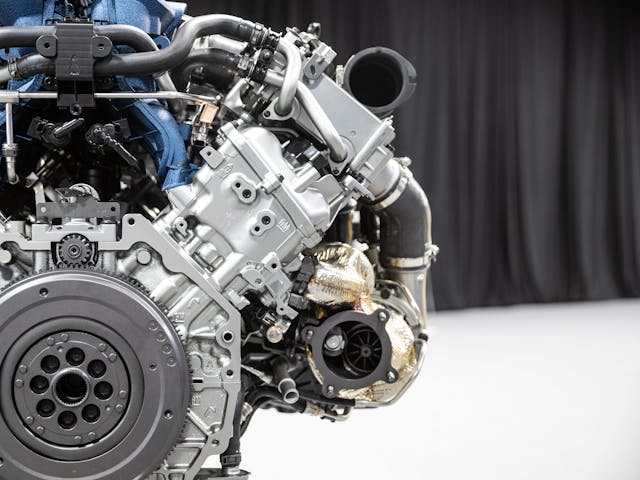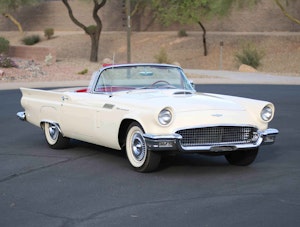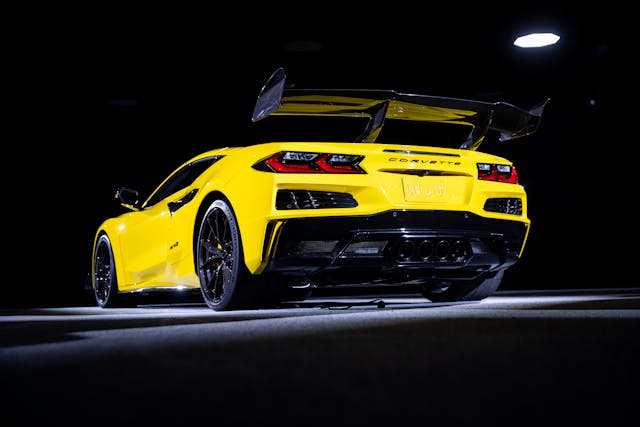Media | Articles
2025 Chevrolet Corvette ZR1: Horsepower Obsession Has Led to This
We wish the tires good luck. When the 2025 Corvette ZR1 arrives in showrooms next year, its massive rear Michelins will be tasked with transferring 1064 horsepower to forward motion. Context is required: Most contemporary passenger cars and crossovers still have fewer than 300 horses. The original 1953 Corvette had just 150 horsepower and even in 1975, the base Vette eked out only 190 hp. Now we have four-figure power for America’s sports car. Incredible.
The new ZR1 is a step change, offering a 41 percent increase in horsepower over the 755-hp ZR1 from 2019. This new model is also tangible evidence that, despite the proliferation of incredibly powerful electric vehicles, combustion engines are still big players in the horsepower wars.
“It’s crazy, just crazy,” said Tadge Juechter, soon-to-be-retired Corvette executive chief engineer, in reference to the new ZR1’s power figure. Juechter started working on the Corvette in 1993 when the base model had only 300 horsepower.



Juechter, an engineer’s engineer who is famous in Detroit automotive circles for his professional discipline and his unerring focus on continually evolving the Corvette into a world-class sports car, shepherded the C8 (eighth-generation) Corvette platform that made today’s ZR1 possible. Its mid-engine layout positioned the motor behind the driver rather than in front, which not only introduced many traction advantages but also provided more room in the engine bay. GM’s engineers took advantage of the space with the all-new 5.5-liter LT6 V-8 that launched in the 2023 Corvette Z06.
Marketplace
Buy and sell classics with confidence
The LT6 is a naturally aspirated, 670-hp firecracker with double-overhead-cam architecture, an obvious break from decades of overhead-valve V-8s. The DOHC layout creates a taller and wider engine but permits higher rpm and, crucially, increased airflow. Engine power is related to how much air moves in and out of the cylinders: more air equals more power because fuel burns oxygen. Corvette engineers leveraged the new hardware to make an 8600-rpm screamer, one of the best engines the General has ever produced.



The LT6 drawing board included a twin-turbocharged version, the LT7, the heart of the ZR1. Powered by exhaust gases, turbos are essentially air pumps that jam more air into engine cylinders. Repeat: more air equals more power. One measurement of the amount of air is pressure. Atmospheric air pressure—what we all experience just being on earth—is about 15 pounds per square inch (psi). The LT7 more than doubles that, adding an additional 20 psi. That boost necessitated additional hardware. Redesigned cylinder heads maximize the pressurized airflow, there are stronger connecting rods and pistons, and a pair of intercoolers (essentially, small radiators) chill the pressurized air.
Turbos spin over 100,000 revolutions per minute (rpm) and, like engines themselves, have a redline. The LT7’s sophisticated electronic sensors measure turbo speed and an electronically actuated wastegate bleeds off exhaust flow to run the turbos close to but not over the 135,000-rpm redline. The 1064-hp peak hits at 7000 rpm, 1000 revs short of redline, and at just 3000 rpm, the engine produces 800 pound-feet of torque, which it maintains through 6000 rpm. Juechter promises the LT7 is “docile around town and when you get on it, it’ll change your life.”

Corvette fans will immediately recognize the ZR1’s new sloping engine cover, which resembles the split-window rear of the 1963 edition. There are also blue accents sprinkled throughout and aerodynamic tweaks, such as a duct that channels cooling air to the rear brakes. The optional ZTK track package adds a comically large rear wing and other downforce enhancements. GM engineers say the ZR1 generates the most downforce in the model’s history. Naturally, engineers retuned the suspension and upgraded the brakes to cope with all the extra power.

The ZR1’s suite of electronic driver aids will be key to keeping the Michelins, some 14 inches wide, from going up in smoke. Official performance figures have not yet been released, but during a media preview, engineers allowed that the ZR1 will run the quarter-mile in under 10 seconds at about 150 mph. Furthermore, they claimed that the ZR1 will accelerate from 80 to 200 mph and then brake back to 80 mph in just 25 seconds.
We don’t yet know what the 1064-hp Corvette will cost, but the Z06 starts at about $110,000, so figure roughly $150,000 for the ZR1. Options will likely drive the price over $200,000, another new frontier for the Corvette. That’s a heady figure, but the ZR1 will maintain the Corvette’s performance value—there’s no car with nearly the same power for less money—and it’s a helluva sendoff for chief engineer Juechter, who is retiring after 47 years of service to the General.
***
Check out the Hagerty Media homepage so you don’t miss a single story, or better yet, bookmark it. To get our best stories delivered right to your inbox, subscribe to our newsletters.










































Very impressive. Chevy has done what few others could do here and made a mega supercar that while is not cheap but one that you will see on the road vs the Ford GT or Enzo.
I saw the pull to 205 MPH and it was effortless.
Now that this is here we had expected 850 HP and electric front drive for the Zora. Is the Zora still on and just what will we see in it?
I just had 4 ZR1 or were they Zora here taking a break in camo in a local parking lot. They also has a Strada with them. Where do they go from here?
Absolutely insane. And that what makes it amazing. Somebody at GM had to recognize the insanity and still had the brass to OK this moonshot. This is why there will always be a Corvette in my garage.
It is not the brass but the ability to do a car like this at the price they will sell it and still make money. Too many cars like this are lost leaders that show no profit. Corvette is held to the standard all models are and they have to make money.
Understood, but there still is one person at GM who must give a project such as this the “thumbs up”. I will assume it was Mary Barra after hearing what her team had to say. I believe there is just one car builder with a dictator and it ain’t GM.
The truth is there are several levels this car could have been killed. Right up to Mary.
The bottom line is this will make money and it will keep the C8 sold out for several more years till the now in development C9 cones out.
When the Corvette C5 program was killed both management and engineering learned the value of this car and if better focus was directed to it they can sone amazing things and make money.
Now if they could learn to do this on other programs.
I love the line, thee 1993 Corvette “had only 300 horsepower.” The word “only” is what makes me laugh, and points out how ludicrous the horsepower wars have become. Away from the track or barstool bragging (“I can go from 0 to ‘Throw me in jail’ in 5 seconds!”), 500+ horsepower is mostly unusable, and just requires added weight and complexity to accommodate it.
Too much is never enough.
I guess you haven’t driven a C8. Thanks to the mid-engine configuration that shifted the weight rearward, you get superior TRACTION that was never available in previous generations. If more than 500 hp was unusable, why is a C8 Z06 quicker in the quarter mile than a Stingray? The answer is that it’s usable.
I know that I have to pay attention when I ‘floor it’ with my 385 horsepower Corvette; it must be downright scary to do that on a car with three times the power.
2025 Corvette aka ‘a tool of the devil’….
I should think they would compare it to the 1993 ZR1 which had 405 Horsepower LT5 that year, out of a Lotus designed 4-Cam/32 Valve engine. Now THAT was one of the best engines GM ‘sort-of’ ever made (as GM owned Lotus at the time) which they farmed out manufacturing/assembly by Mercury Marine’s MerCruiser division, essentially hand-built engines; maybe the reason they were one of the most reliable V8s GM ever ‘sort-of’ made.
Superb. Forty years ago I bemoaned the state of the General’s army, following the introduction of a truly anemic Vette with a cross ram small block. My faith Is restored.
Personally, I prefer sports cars to super cars, but when the C8 came out, it was just too good in all ways for me to settle for just a sports car. The Z06 and now the ZR-1 push the Corvette further into the super car stratosphere. I am sure that a lot of people will appreciate that, but smaller and lighter would suit me better – but don’t get me wrong – my Z51 C8 is amazing. I just don’t think I need more power.
Amazing specs and likely one of the greatest combustion powered cars to exist. I’m looking forward to seeing what this can do.
Gary, I think this will be faster than the MKIV Supra. Looks like fun! The challenge is to stay out of jail…….
Oh the C8 is faster, no need to ZR1 to be faster. Stay out of jail, hmm, need to race in “Mexico”.
Most people I know couldn’t handle 400 HP.
Give me a C1 or C2 any day.
Exactly, anything above 400 hp is a death sentence. You’ll do yourself in, or more importantly someone else because 99% of you can’t handle that craziness.
You want to see crazy? You should meet both my ex wives!
You married them, what does that make you? lol
Mike is right and wrong at the same time. Do you need more than 400HP for a street driven car-definitely the answer is “No”. Is a car with a 1000 plus HP a “death machine” – the answer to that one is “it depends”. Depends on both the electronic assists and a driver (mostly) who is smart enough to realize that other than a small number a talented individuals you are not good enough to drive at the max without the nannies saving your butt. Just watch the videos of guys leaving Cars & Coffee events to see what a heavy right foot and shortage of talent gets you. In the end unless you are on the track all that HP is nothing other than a lame attempt at “male enhancement”.
My modified aftermarket 7.0L ’04 GTO dyno’ed at 535hp at the crank. It runs a small diameter multidisc clutch/Tremec 6spd. Neither the HP nor I have even slightly injured anyone- save the egos of the fart can FWD brigade, who deserve it anyway😋.
What’s the point? Oh, I get it—fodder for another stolen car chase by the Arkansas State Police for their YouTube channel. Will wind up in a tree somewhere, by driver error or pit maneuver, whichever comes first.
I’m probably in the minority here but…. I could only imagine that Raph Nader must be thinking. After all he thought that the 60 hp Corvair was unsafe at any speed. While this may be great for some people, I don’t feel this need for speed or hp any longer, even though I do love to drive. I think that I will stay with my little almost 50 yo car and 30 yo Cruiser van. As for my daily driver, the little, leased Honda will do just fine.
While I agree with your point that high-horsepower cars are not for everyone, there was no 60hp Corvair. The lowest-rated Corvair was 80hp and the power was not a factor in the Unsafe at Any Speed conversation. That one chapter of Nader’s book was about suspension design and the Corvair was completely vindicated in a 1972 NHTSA report. No need to spread misinformation.
thanks for saving me the time.
Had a 1963 Corvair modified with high rise manifold and large 4 barrel carb and exhaust system. No problems in curves, but a so called fender bender and the entire front end collapsed, no frame. I know I had one.
That collapsed front was actually safer. A pre-cursor to modern day crumple zones.
Amen.
In college I was told that the Corvair steering (not suspension), in engineering terms, had a pole in the right hand plane. Some will understand this, many will not. Having a pole in the right hand plane means positive feedback.
Every modern car’s steering has negative feedback. You turn the wheel, the car turns, then let go of the wheel and the car straightens out. With positive feedback you turn, then let go of the wheel, the car turns even more. This is what supposedly made the car unsafe (roll).
I’ve never driven one, and I don’t know if this is correct or not, but at the time it made sense.
Agree. I find it hard to believe that the Feds have allowed this horsepower madness to exist in street cars.
Invest now. These cars will become ultra-rare after all the vehicles totalled by completely unqualified drivers are subtracted from the herd.
B
Eventually they’re just gonna strap a jet engine to the roof and call it good.
Mythbusters did that with a ’66 Impala and a rocket. I highly recommend that episode.
This is impressive. I was expecting this engine to be combined with the E Ray electric motor (to provide more traction) for a total of around 1000HP. No matter how you look at it, this demonstrates GM’s engineering capabilities are the equal of any of its European competitors.
For decades I’ve said ” I’ve never driven a street car that couldn’t use another 100 HP, this new ZR1 might just be the exception, I sure wish GM would put a 3rd pedal and a manual gear box in!
While I can understand, I do love my manual transmissions, these late model automatics are nearly miraculous with the number of speeds, from great for acceleration to high fuel mileage, and their ability to shift faster than a manual. Performance wise, they’re probably the better choice.
There’s certainly a loss in tactile feel of driving though.
R&D drives advances in technology with trickle-down to all projects. Don’t appreciate or can’t afford it, then don’t buy one. But don’t hide behind Nader-danger, when it’s just plain old envy. My 2019 GS with 400+ bhp can easily scare the crap out of me, but I’d still love to drive this ZR-1 around a track at least once – okay, maybe AT LEAST ONCE – ALL DAY! Hat’s off to Tadge and his team, what a great way to exit. Thanks for all you’ve for the Corvette.